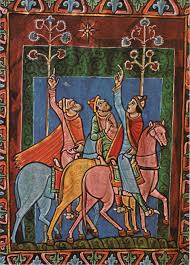Sometime in the twelfth century, perhaps soon after the consecration by Thomas Becket of the Abbey Church, a terrible plague fell upon Reading. Young and old alike, anyone vulnerable to the bite of an infected flea in an age where everyone was permanently flea-bitten, succumbed like wheat before the scythe to this terrifying disease.
All normal commerce was suspended. The townsfolk kept to their houses, their anxiety almost unbearable. When a sufferer exhibited the first symptoms of the disease – a headache to start with, then debilitating chills and fever – it was like the delivery of a death sentence.
People very occasionally recovered, but most would suffer appallingly for a week, until, sapped of all their strength, death brought the release for which they must, by then, have craved. Nauseous, aching all over, they shrank with anguished cries from the light, the brightness being more than they could stand. Then came the swellings, usually after a couple of days, agonising, hard swellings that sometimes grew to the size of an orange, on the neck, arms, inner thighs, swellings that were soon black in their vileness and bursting with pus and blood. Yet this was not the most excruciating phase of the disease, for then they started to bleed internally, and to leak blood from every orifice. Sufferers already stank of death by the time they expired, with their helpless husbands, wives, parents or children looking on in horror and wondering when their own turn would come. They was nothing they could do, other than wait to load the battered, unrecognisable corpses onto the carts that came to carry away the dead.
The poor and afflicted would usually have turned to the monks of the Abbey for succour, but the infirmary there was already packed with their own people. Thirteen Reading monks perished from the disease in the course of that year. Their only hope was in prayer, for a strong wind that would blow away the foulness in the air, yet it seemed to the monks that God was punishing them for their sins and that they needed to persuade Him of their merit.
In a great act of faith, the monks of Reading Abbey, who had complete authority over the town, resolved at length on a course of decisive action. A decree was issued to all the able-bodied townsfolk. Rather than wait to put out their dead, they were told to lay out their sick relatives on litters in the streets. Fearful of leaving their homes, they were told nonetheless to assemble in the vast Abbey church for a service. A fast was proclaimed, and special litanies were sung in front of the congregation. The monks then led a solemn and orderly procession through the streets, holding aloft their most sacred relic, the hand of St James the Greater, and invoking him before God as their protector.
It was subsequently affirmed that a miracle was worked that day, that the sick lying on their litters, having once caught sight of the bejewelled reliquary containing the hand, were cured of their affliction. It was as if the Lord had been appeased in that hour and had instantly allayed the grief of His people, who returned joyfully to their homes, to be free of the epidemic for many years to come.
In the decades since the founding of the Abbey by Henry I, who had entrusted this prized relic to its care, a number of miraculous cures had been credited to the saint. There had been a catalogue of incidents in the mid-1150s. A knight called Mauger Malcuvenant had been restored to life by drops of water in which the holy reliquary had been dipped; a woman from Earley, a nearby village, had been cured of her dropsy after praying in the Abbey church; and a man from Barking had, after keeping vigil there overnight, miraculously regained the power of speech. The lifting of the Reading plague was St James’s most dramatic intervention to date, greatly enhancing his reputation as a miracle-worker and, as a centre of pilgrimage, that of the Abbey, where he was believed to be a living presence.

